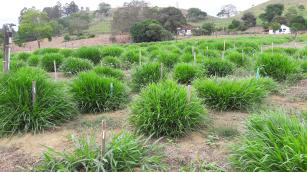Third breeding cycle of Brachiaria ruziziensis for use of the species in crop, livestock and forest integration systems
Third breeding cycle of Brachiaria ruziziensis for use of the species in crop, livestock and forest integration systems

Photo: Sobrinho, Fausto
Pastures assume a prominent position in the Brazilian agricultural scenario. The area occupied by forage plants accounts for three quarters of the national agricultural area. Pasture, as an exclusive food source, is the basis for nearly 90% of the beef consumed in Brazil and most of the milk produced in the country. It is estimated that, in Brazil, the grasses of the Brachiaria genus are cultivated in approximately 84 million hectares. Despite the nationwide importance of this grass for cattle raising, the amount of information available remains limited, especially for supporting breeding programs. In Brazil, the most cultivated Brachiaria species are B. decumbens, B. brizantha, B. humidicola and B. ruziziensis. With the increase in integration between agriculture, livestock and forest, the demand for B. ruziziensis seeds has risen sharply in recent years, since it is the only sexual and diploid species of Brachiaria cultivated in Brazil, thus allowing the accomplishment of crosses and generation of variability for later work of genetic improvement. Initial results evidenced the existence of great genetic variability within the species, allowing to anticipate the possibility of success with selection. The objective of this project was to obtain improved cultivars of Brachiaria ruziziensis with high dry matter yield and forage quality for use in crop, livestock and forest integration systems (either as animal feed or cropping straw). Efforts were focused on the evaluation of forage yield and quality and estimation of genetic parameters of B. ruziziensis clones; conduction of cytogenetic characterization of the germplasm; verification of genetic variability for tolerance to biotic and abiotic stresses; and identification and selection of the best clones to obtain an improved population (cross-linking). From seeds of the population of the second recurrent intrapopulation selection cycle, clones were selected to be evaluated in field, laboratory and greenhouse experiments. For evaluations of tolerance or resistance to stress, progenies of half-sibs were obtained from the selected clones. Based on these evaluations, the best clones were identified and will be cross-linked to obtain the improved population. This population will serve as a basis for the continuity of the breeding program of the species.
Ecosystem: Atlantic Forest, Cerrados Region
Status: Completed Start date: Sat Dec 01 00:00:00 GMT-03:00 2012 Conclusion date: Mon Nov 30 00:00:00 GMT-03:00 2015
Head Unit: Embrapa Dairy Cattle
Project leader: Fausto de Souza Sobrinho
Contact: fausto.souza@embrapa.br
Keywords: melhoramento vegetal, qualidade da forragem, palhada
